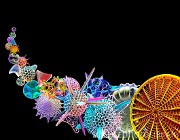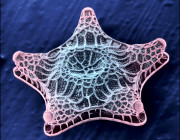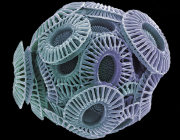Home :: List of Publicly Available Datasets :: Noctiluca scintillans Unknown
Noctiluca scintillans Unknown
Downloads:
| Principle Investigator(s) | Juan Saldarriaga |
|---|---|
| External sample ID | Noctscin |
| NCGR Sample ID | MMETSP0253 |
| Sample accession number | CAM_SMPL_002497 |
| Assembly accession number | CAM_ASM_000315 |
| Combined Assembly Name | N/A |
| Genus | Noctiluca |
| Species | scintillans |
| Strain | Unknown |
| Clonal | No |
| Axenic | No |
| Prelim. NCBI Taxon ID | 2966 |
| 18S rRNA | |
| Importance of organism and transcriptomes | Noctiluca scintillans is a common, bloom-forming voracious predator in the plankton of all oceans. It is a very atypical dinoflagellate, and much of its biology, especially in regards to the organization of its nucleus is not understood. Its vegetative life stage is up to 2 mm in diameter, and much of its volume is a vacuolar space. Whether or not its exceedingly large nucleus is dinokaryotic in this stage has not been determined, but it is capable of making flagellated stages, probably gametes, that do have the typical dinoflagellate morphology and a typical dinoflagellate nucleus. Noctiluca is otherwise interesting for several reasons. First, it is capable of producing spectacular orange blooms that, although not toxic in themselves, have caused problems by producing large quantities of ammonia, blocking sunlight and depleting oxygen. Second, it is one of the most bioluminescent of dinoflagellates. Third, some strains are capable of harbouring green prasinophytes within their vacuolar system and become practically autotrophic; very little is known about how this endosymbiosis works. And fourth, the phylogenetic position of the whole order is contested but may be pivotal to understanding the evolution of many strange dinoflagellate characters because it may be an early-branch. |
| Additional citations and references | Gomez, F., Moreira, D. and Lopez-Garcia, P. 2010: Molecular phylogeny of noctilucoid dinoflagellates. Protist 161: 466-478 |
| Environmental Data | |
| Primary citation for organism's characterization, if available | Hoppenrath, M. and Leander, B. 2010: Dinoflagellate phylogeny as inferred from heat shock protein 90 and ribosomal gene sequences. PLoS One 5: e13220 |
| Collection date | 12-APR-94 |
| Sample collection site | Puget Sound, WA |
| Sample material (e.g. "seawater," "sediment," etc.) | seawater |
| Habitat | marine habitat |
| Country | UNITED STATES |
| Experimental Data | |
| Date of experiment | 18-JUL-11 |
| Growth medium | HESNW |
| Modifications to growth medium | no silica |
| Temperature (ºC) | 16 |
| Salinty (psu) | 30 |
| pH | 7 |
| Light (µmol photons / m2 / sec) | 3800 |
| Day portion of day:night cycle in hours | 14 |
| Night portion of day:night cycle in hours | 10 |
| Nitrate (μmol/L) | 3 |
| Ammonium (μmol/L) | .11 |
| Phosphate (μmol/L) | .3 |
| Investigation type | Eukaryotes |








